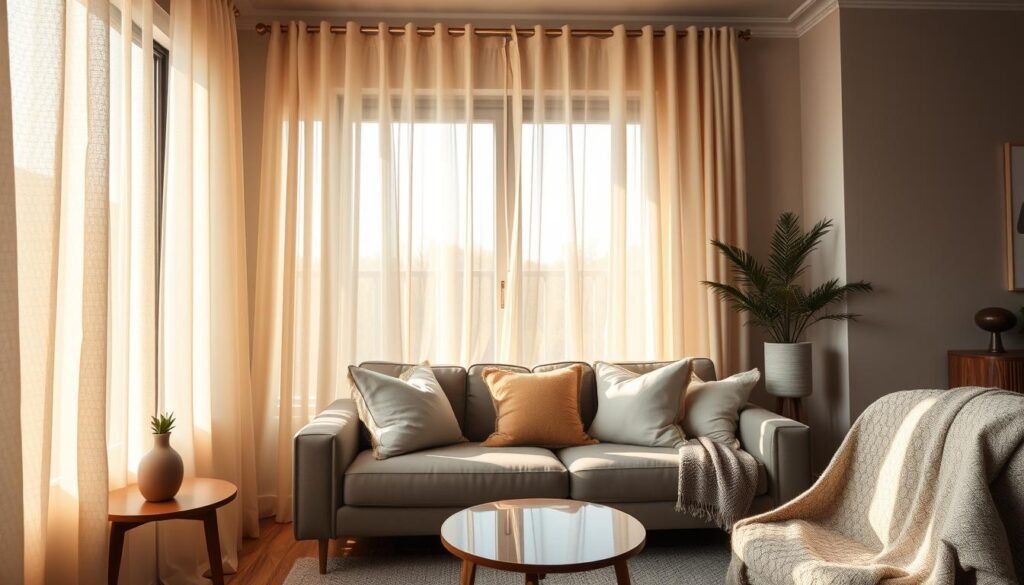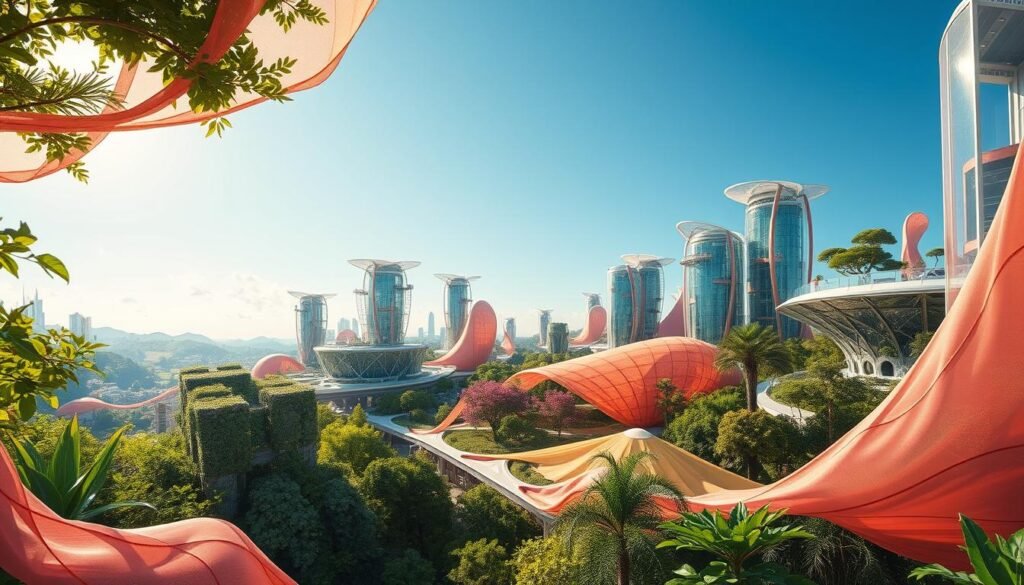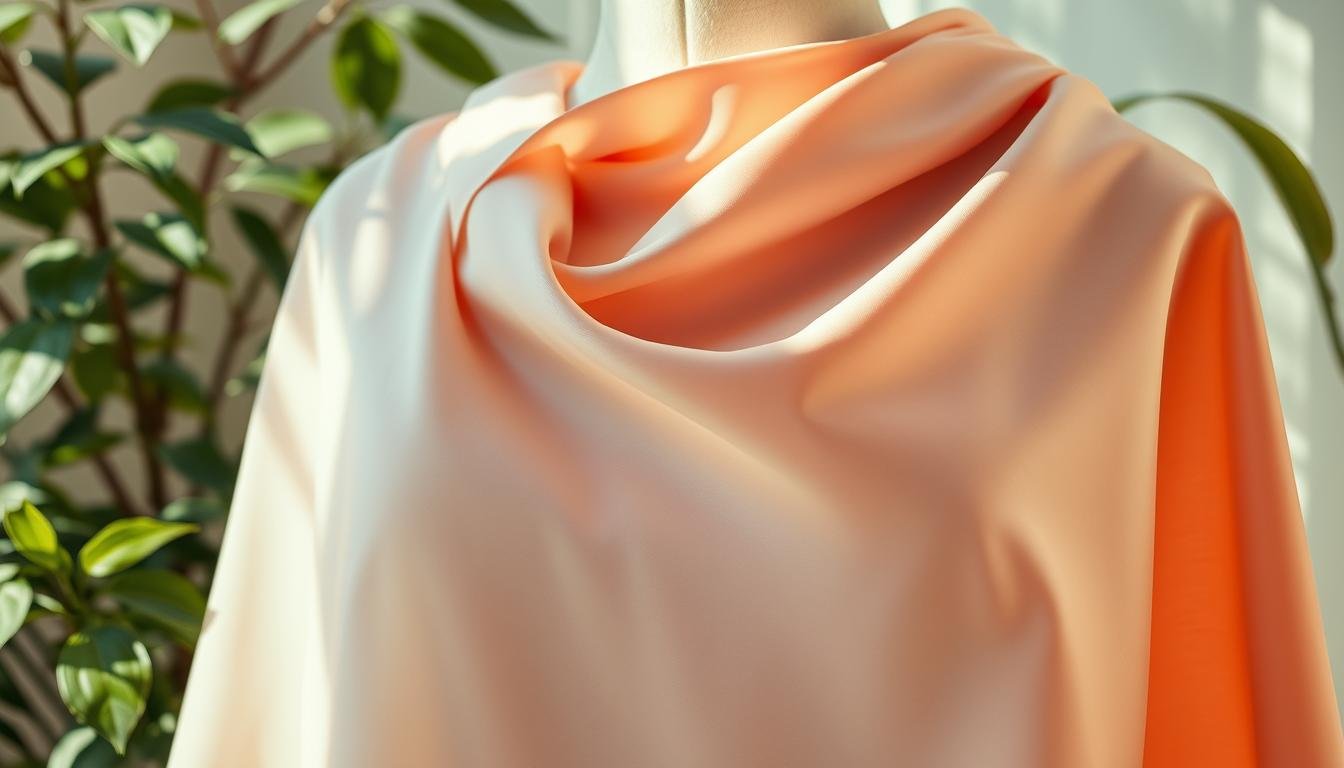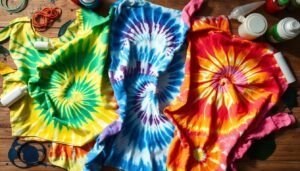“The greatest danger in times of turbulence is not the turbulence—it is to act with yesterday’s logic.” – Peter Drucker. Today, we’re focusing on sustainable choices and the materials we use. Rayon is a key player, known for being soft, versatile, and eco-friendly. It’s made from cellulose-based textiles.
This article will cover the basics of rayon fabric. We’ll talk about its origins, how it’s made, its types, and its role in sustainable fashion. We’ll see why it’s a top choice for those who care about the planet. With partners like Beytown Textile, we’re here to highlight rayon’s unique benefits in the fashion world.
Key Takeaways
- Rayon is the third most popular textile worldwide, showcasing its market demand.
- Rayon is derived from cellulose fibers, making it a semi-synthetic yet versatile fabric.
- Despite its eco-friendly claims, the production of rayon raises concerns about deforestation and chemical use.
- Rayon offers silk-like softness and has a lower environmental impact than silk or cotton.
- Understanding the complexities of rayon manufacturing helps consumers make informed choices.
- The fabric’s ability to biodegrade enhances its reputation as a sustainable option.
What Is Rayon Fabric?
Rayon fabric is a semi-synthetic fiber made from cellulose, often from wood pulp. It combines the softness of natural fibers with the durability of synthetic ones. This makes it a popular choice for clothing, from dresses to blouses.
Definition and Composition
Rayon is a semi-synthetic fiber derived from natural cellulose in wood. The process to make it involves chemical treatments to turn cellulose into a fiber. While it starts with natural fibers, its extensive processing makes it different from pure natural options like cotton or wool.
Comparison with Natural and Synthetic Fibers
Rayon blends traits from both natural and synthetic fibers. It has the softness and color retention of natural fibers, ideal for fashion. Yet, it also has moisture-wicking and wrinkle resistance like synthetic fibers.
The History of Rayon Fabric
Rayon’s story is full of innovation and change. It shows how this fabric changed the textile world. Let’s dive into its beginnings and growth.
Origins of Rayon Discovery
In the late 19th century, French chemist Hilaire Bernigaud, comte de Chardonnet, created rayon. He called it “artificial silk.” This was during a time when silkworms were dying off due to disease.
Chardonnet’s early work led to the creation of Chardonnet silk. Later, it was renamed rayon. Dupont started making it commercially in the early 1900s.
Development Through the 20th Century
By 1910, people were selling rayon as viscose. This was a big step in rayon history. In 1924, they made manufacturing it easier and bigger, speeding up production in the U.S. and Europe.
The 1940s brought high-tenacity rayon, perfect for industrial uses like tire cords. By the 1950s, rayon was a big deal in clothes and home fabrics.
Now, rayon is a top man-made fiber. It comes in different types for clothes and home items. Thanks to new ways of making it and eco-friendly options, rayon stays popular and useful.
For a quick look at viscose fabric, see this resource.
How Rayon Fabric is Made
The rayon manufacturing process begins with the raw materials. These include cellulose, which comes from wood pulp of trees like beech, pine, and bamboo. This makes rayon a semi-synthetic fiber.
Raw Materials Used
Here are the main raw materials for making rayon fabric:
- Wood pulp from trees such as pine or beech
- Cotton linters from cotton-seed residue
- Bamboo, known for its fast growth and eco-friendliness
Every year, over 150 million trees are cut down for making cellulosic fabrics. This shows how big the rayon production is.
The Manufacturing Process Steps
The viscose process for making rayon has several steps:
- Pulping: The wood pulp is cleaned to remove dirt.
- Dissolving: The pulp is dissolved in chemicals to make a thick solution.
- Extrusion: This solution is pushed through a spinneret to create fibers.
- Regeneration: The fibers are treated in baths to make them solid.
- Finishing: The fibers get more treatments to improve their quality before becoming yarn.
This rayon manufacturing process uses a lot of chemicals. This can harm the environment by causing pollution and using up natural resources. The increase in production also leads to deforestation, which hurts our planet.
Types of Rayon Fabric
Rayon fabric comes in many types, each with its own unique features. Knowing about these types helps us see their strengths and uses in the textile world.
Viscose Rayon
Viscose rayon is the most common type. It’s known for its silky feel and looks luxurious. Often mixed with other fibers, it gets stronger and less wrinkly. This mix makes it a top pick for many clothes.
Modal Rayon
Modal rayon comes from beechwood pulp and is super soft. It’s stronger when wet than viscose, making it great for durable items. Clothes made from modal keep their shape well, even after many washes.
Lyocell Rayon
Lyocell rayon, also known as TENCEL™, is known for being eco-friendly. It uses less water and chemicals than other rayons. Its great moisture control and stretch make it perfect for workout clothes and casual wear.
Cupro Rayon
Cupro rayon combines cotton waste to feel like silk. It comes in light and heavy versions for different uses, from blouses to skirts. Its softness and flow make any outfit look better.
| Type of Rayon | Main Benefits | Common Uses |
|---|---|---|
| Viscose Rayon | Soft, luxurious feel Highly absorbent |
Dresses, blouses, everyday clothing |
| Modal Rayon | Superior softness Increased durability |
Socks, undergarments, loungewear |
| Lyocell Rayon | Eco-friendly Excellent moisture control |
Activewear, casual wear, denim |
| Cupro Rayon | Silk-like texture Breathable |
Skirts, blouses, high-end fashion |
Rayon Fabric Properties
Rayon fabric is a favorite in fashion for its special qualities. It’s both comfy and stylish, making it a top pick for designers and shoppers. Let’s dive into what makes it a great choice for our clothes.
Softness and Touch
Rayon is known for its silky smooth texture. It’s as soft as silk but more comfortable. This makes it perfect for clothes that are both fashionable and gentle.
Breathability and Moisture Wicking
Rayon is a breathable fabric that absorbs moisture well. This keeps us cool and dry, especially when it’s hot. It helps prevent sweat buildup, keeping us comfy in any weather.
Drapability and Flow
Rayon’s drapability makes it stand out. It moves beautifully, adding elegance to dresses and blouses. This feature boosts the look and feel of clothes, making them both stylish and comfortable.
Benefits of Using Rayon Fabric
Rayon fabric is a top choice in fashion for many reasons. It’s an affordable silk alternative, letting us enjoy luxury looks without spending a lot. This fabric is budget-friendly and offers many benefits that make it stand out.
Affordable Alternative to Silk
Rayon is known for being affordable. It feels and looks like silk but costs much less. This means we can wear beautiful outfits without breaking the bank. It makes luxury fashion available to more people, letting everyone enjoy elegant clothing.
Rich Color Absorption
Rayon is great at soaking up dyes, creating vibrant colors. This makes our clothes pop and grab attention. With rayon, we have endless color choices for our outfits, helping us show off our style.
For more details about the characteristics of rayon, check out this in-depth guide.
Versatility in Fashion
Rayon is versatile in fashion. It can be mixed with other materials for different looks, from casual to formal. Whether we want flowy dresses or structured blouses, rayon delivers. Its light weight makes it comfy for any season, making it a key piece in our wardrobes.
Drawbacks of Rayon Fabric
Rayon fabric is known for its beauty and comfort. But, it has some downsides to consider. These include concerns about durability and environmental impact.
Durability Concerns
Many people question rayon’s durability. It feels soft and looks bright, but it’s not as tough as some other fabrics. Here are some reasons why:
- Rayon can shrink, even when washed in cold water.
- It gets weaker when it’s wet, making it more likely to get damaged during washing and drying.
- It doesn’t bounce back well, so it can wrinkle and tear easily.
- You’ll need to iron or steam it often to keep it looking good.
So, you have to be careful with rayon clothes to make them last longer.
Environmental Impact of Production
Creating rayon has big environmental issues. The process involves chemicals that harm the planet. Here are some key points:
- It uses chemicals that pollute the environment.
- Its production is not very eco-friendly, which worries people who care about the planet.
- Getting rid of rayon fabric at the end of its life is a big problem, thanks to its chemical makeup.
Knowing these issues helps us think more about the choices we make with rayon.
| Aspect | Rayon |
|---|---|
| Durability | Low; prone to shrinking and wrinkling |
| Sensitivity to Water | Weakens when wet, risking damage |
| Environmental Impact | Involves harmful chemical processing |
| Preferred Cleaning Method | Dry cleaning recommended |
Is Rayon Fabric Eco-Friendly?
The debate on whether rayon fabric is eco-friendly is complex. We need to look at how it’s made and where its raw materials come from. Rayon is mostly made from cellulose, which comes from wood pulp. But, how we get these resources is key to being sustainable.
Sourcing Sustainability
Canopy, a non-profit, says over 300 million trees are cut down yearly for making cellulosic textiles, like rayon. Many of these trees come from old and endangered forests in places like Indonesia, Brazil, and Canada’s Boreal. This leads to deforestation, hurting nature and people who depend on forests.
But, there’s hope. Companies like Lenzing Group are making sustainable rayon fabrics. They use responsible forestry and get certified by the Forest Stewardship Council. This ensures they’re taking care of the environment.
Impact of Chemical Processing
Rayon’s chemical process can create toxic byproducts, affecting workers and the planet. Old methods can pollute the environment. But, new solutions are coming.
Companies like Evrnu and Orange Fiber are making fibers from old clothes and citrus juice leftovers. This reduces waste and cuts down on harmful chemicals. Tencel™ Lyocell also recycles water and solvents, making it better for the planet.
| Aspect | Traditional Rayon | Sustainable Rayon Options |
|---|---|---|
| Source of Cellulose | Trees from endangered forests | Forestry certified by FSC or PEFC |
| Toxic Byproducts | High | Minimized through innovative processes |
| Recycling Methods | Limited | Closed-loop systems available |
| Overall Environmental Impact | Significant | Reduced with sustainable practices |
Better Types of Rayon
Choosing sustainable fabrics is key, and knowing about different rayon types is crucial. Recently, new rayon options have come out for eco-friendly shoppers. Lyocell and bamboo rayon stand out because they affect the environment in different ways.
Lyocell as a More Sustainable Option
Lyocell, also known as Tencel, is a greener choice in rayons. It uses a closed-loop process that recycles solvents and water. This reduces waste and makes lyocell better for the planet. It’s a top pick for those who want to be eco-friendly without giving up quality.
Bamboo Rayon: The Sustainability Debate
Bamboo rayon is a topic of debate in sustainability. Bamboo is naturally eco-friendly, but making it into fiber is another story. The process involves a lot of chemicals, which can be bad for the environment. Buyers should look into how bamboo rayon is made before deciding if it’s truly sustainable.
Common Uses of Rayon Fabric
Rayon is a versatile fabric used in fashion and home textiles. It’s popular for many reasons, thanks to its unique qualities. It fits a wide range of uses.
Apparel and Fashion
Rayon is often seen in dresses, blouses, and skirts. It’s light and breathable, making it comfy for any season. Viscose rayon is the top type, mixing well with other fibers for different textures and styles.
High-wet-modulus (HWM) rayon is another great choice. It’s perfect for activewear like sports bras and leggings.
Home Textiles
Rayon is big in home textiles too. It’s used in curtains, pillowcases, and bed linens for their elegant look and feel. It makes our homes look stylish and feel cozy.
Its ability to wick away moisture makes it great for sheets and towels. This keeps us cool and relaxed at home.

| Application | Description | Benefits |
|---|---|---|
| Apparel | Dresses, blouses, skirts, leggings, and activewear | Lightweight, breathable, versatile fabric applications |
| Home Textiles | Curtains, pillowcases, bed linens, and towels | Elegant drape, comfort, moisture-wicking |
How to Care for Rayon Fabric
Caring for rayon fabric needs special attention to keep it looking great and lasting longer. By following the right care tips, we can enjoy our clothes for many years. Knowing how to wash and take care of it makes a big difference.
Washing Instructions
When washing rayon clothes, we must be careful. Here are key tips for cleaning rayon well:
- Use warm water and a mild detergent.
- Agitate gently for three to five minutes, avoiding harsh wringing or twisting.
- Hand washing or using the delicate cycle on the machine is recommended to prevent shrinkage.
- Always adhere to care labels; some rayon blends with cotton are machine washable.
- Avoid using chlorine bleach or harsh cleaners, which can damage the fibers.
- For stain removal, a mixture of distilled white vinegar and water can be applied, followed by blotting with clean towels.
Best Practices for Longevity
To make sure our rayon clothes last, we should do the following:
- Store rayon items on sturdy hangers or fold them flat to avoid creasing.
- Avoid plastic dry-cleaning bags for extended storage to prevent yellowing.
- Iron at low heat, preferably inside out while the fabric is slightly damp, to avoid shine.
- Use a protective barrier, such as a hand towel, while ironing to help prevent damage.
- For larger items like drapes, fold along seams for storage or use plastic containers to prevent pressure on the fabric.
- Implement wrinkle-releasing sprays as a heat-free solution to remove creases.
By using these tips and washing instructions, we can keep our rayon fabrics looking beautiful and lasting longer. This ensures they stay a part of our wardrobes for years.
Rayon Fabric in Fashion Trends
Rayon fabric is now a key player in fashion, loved for its luxurious feel and comfort. It’s becoming more popular in clothes because of its versatility. Designers love it for creating unique and practical clothing styles.
Current Popularity in Apparel Design
The global fashion market, worth over $2.5 trillion, has taken a shine to rayon. It’s a budget-friendly option that’s softer and more absorbent than cotton. Its beautiful drape makes rayon clothes very sought after.
Brands are now pushing the limits of fashion with rayon. They make everything from casual outfits to fancy dresses using this fabric. Rayon is becoming a staple in many fashion collections.
Innovation in Rayon Blends
Designers are mixing rayon with other fabrics like cotton and polyester. This creates stronger and textured garments. The unique looks they achieve while keeping rayon’s softness and drape are impressive.
Rayon’s eco-friendly production process is attracting brands focused on sustainability. Its closed-loop production cuts down the fashion industry’s carbon footprint. Choosing rayon helps us build a sustainable wardrobe that matches our values.
| Feature | Rayon | Cotton | Silk | Polyester |
|---|---|---|---|---|
| Price Range | Moderate | Higher | Higher | Lower |
| Softness | Soft | Soft | Very Soft | Less Soft |
| Breathability | High | High | Medium | Low |
| Drape | Excellent | Good | Excellent | Poor |
| Shrinkage | Prone | Minimal | Minimal | Minimal |
| Durability | Lower | Higher | Higher | Higher |
Shopping for Rayon Fabric
When we shop for rayon fabric, we aim to find high-quality products. These should be known for their craftsmanship and look. Choosing the right fabric is key to our clothing choices. It’s important to think about where it comes from and how it’s made.
Finding High-Quality Rayon Products
High-quality rayon feels luxurious and drapes well. When looking at fabrics, we should focus on these key points:
- Softness: This makes the fabric comfortable against our skin.
- Breathability: It keeps us cool in all weather.
- Color Richness: These colors stay vibrant even after many washes.
We should look for brands that value quality. They offer a wide range of products, from dresses and blouses to activewear. With 1,946 rayon options, we can easily find what we need.
Identifying Environmentally Friendly Brands
It’s also important to choose brands that are good for the planet. Many brands use sustainable materials like TENCEL™ lyocell. This shows they care about the environment:
- TENCEL™ as an eco-friendly alternative: It’s made from wood pulp in a closed-loop process.
- Sustainable sourcing: These brands focus on responsible harvesting.
Choosing brands that share our values makes shopping better. It also helps the textile industry become more sustainable. By being careful with our choices, we help make rayon a greener option.
Comparing Rayon Fabric to Other Materials
Understanding the differences between rayon and other fabrics like cotton and polyester helps us make better choices. Each material has its own strengths and weaknesses. These differences meet different needs and preferences.
Rayon vs. Cotton
Rayon and cotton have their own benefits. Rayon is better at absorbing moisture, which is great for humid places or items that need to keep cool. Cotton is strong and lasts a long time, making it perfect for everyday clothes and towels.
Rayon gets weaker when it’s wet, which is a drawback. Cotton stays strong and doesn’t lose shape easily. This makes cotton great for clothes you wear every day.
When it comes to comfort, both fabrics are top-notch. Rayon feels as soft as natural fibers and moves well with the body. Cotton is also soft but doesn’t stretch much, keeping clothes looking neat.
Price and sustainability are big factors in choosing fabrics. Cotton is usually pricier than rayon. Cotton’s effect on the environment depends on how it’s grown, while rayon’s impact comes from how it’s made.
Rayon vs. Polyester
Looking at rayon versus polyester, rayon is better at letting air through, which is good for hot weather. Polyester is strong and doesn’t let water in, making it great for tough conditions.
Both fabrics are good for the planet and don’t cost too much to make. Rayon drapes nicely but wrinkles easily. Polyester doesn’t wrinkle much, keeping clothes looking sharp.
How you take care of these fabrics is very different. Rayon needs special cleaning, while polyester can go in the machine. Rayon can change size or shape with washing, but polyester stays the same.
| Feature | Rayon | Cotton | Polyester |
|---|---|---|---|
| Absorbency | Superior | Good | Poor |
| Durability | Weaker when wet | Strong and durable | Very strong |
| Breathability | High | Moderate | Low |
| Wrinkle Resistance | Moderate | Low | High |
| Care Instructions | Usually dry clean or hand wash | Machine washable | Machine washable |
Future Outlook for Rayon Fabric
The future of rayon fabric looks bright as it adapts to new technologies and sustainable trends. We see a big growth in the rayon market, with areas like clothing, home decor, and industrial uses leading the way. New innovations could change what consumers want and how businesses operate.
Emerging Trends and Technologies
Rayon comes in two types: viscose staple fiber and viscose filament fiber, each with its own benefits. In 2022, the global rayon fibers market was worth about USD 17.71 billion. By 2030, it’s expected to jump to USD 28.66 billion, growing at a 6.3% annual rate. Rayon is becoming more popular in various fields, like medical textiles and car interiors, showing its versatility and importance.
The lyocell segment is also expected to grow fast, thanks to its eco-friendliness. This shows how sustainable choices are influencing the market.
Potential for Greater Sustainability
More people want eco-friendly options, pushing brands to find new ways to make rayon. Companies are working on sustainable methods to lessen the environmental harm of making rayon. This matches the growing need for textiles that are both comfy and ethically made.
Together, we can create a future where rayon is both stylish and green. This could inspire a new wave of rayon textiles that are fashionable and sustainable.

Conclusion
Rayon fabric is a mix of luxury, versatility, and eco-friendliness. It’s a top pick for fashion and home textiles. We’ve looked at its many benefits, like being almost twice as absorbent as cotton and feeling like silk.
But, we must think about the environmental impact of making it. This encourages us to choose sustainable fashion whenever we can.
At Beytown Textile, we focus on quality rayon products that are good for the planet. We use sustainable materials and eco-friendly ways to make our products. Thanks to new tech like lyocell and modal rayon, we can enjoy this fabric’s special qualities while helping the planet.
When we make smart choices about fabrics, we improve our wardrobes and help the environment. Choosing responsibly sourced rayon supports sustainable production and healthy earth practices. This leads to a future where fashion and the planet go hand in hand.
FAQ
What is rayon fabric?
Rayon fabric comes from cellulose, mainly from wood pulp. It’s not fully natural because of the chemical process it goes through.
Is rayon fabric eco-friendly?
Rayon’s eco-friendliness is tricky. It comes from renewable sources but its production can harm the environment. This is due to deforestation and toxic chemicals.
What are the different types of rayon fabric?
There are several types of rayon, like viscose, modal, lyocell, and cupro. Each type is suited for different uses, from clothes to home decor.
How should I care for rayon fabric?
To keep rayon looking great, wash it by hand or on a gentle machine cycle. Always follow the care label for the best results.
What are the benefits of using rayon fabric?
Rayon is known for its smooth feel, breathability, and ability to take on vibrant colors. It’s a silk-like fabric at a lower cost.
What are the drawbacks of rayon fabric?
Rayon can tear easily and shrink, which affects its durability. Its production also has environmental downsides.
How does rayon compare to cotton and polyester?
Rayon is softer and drapes better than cotton but isn’t as durable. It’s more breathable than polyester but not as tough.
What makes lyocell rayon a more sustainable option?
Lyocell, known as TENCEL™, uses a closed-loop process. This process recycles chemicals and water, making it less harmful to the environment than other rayons.



